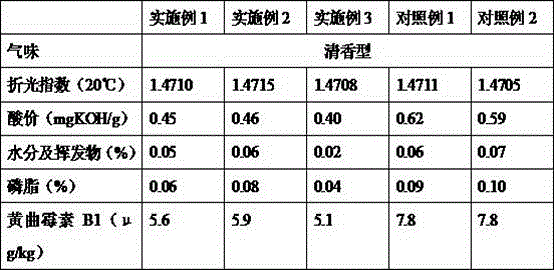Fine processing method for cold pressing of peanut oil
A peanut oil, low temperature technology, applied in the direction of fat oil/fat refining, fat production, fat oil/fat production, etc., can solve the problems of inability to remove aflatoxin and poor purity of peanut oil.
- Summary
- Abstract
- Description
- Claims
- Application Information
AI Technical Summary
Problems solved by technology
Method used
Image
Examples
Embodiment 1
[0024] The first step is to remove the red skin of the peanuts, then dry them at 80°C until the moisture content is less than 5%, and then crush them;
[0025] In the second step, the crushed material obtained is sent to a low-temperature press for pressing, the pressing temperature is 45°C, and the pressing chamber pressure of the press is 3.0Mpa to obtain crude oil;
[0026] Step 3: Filter the crude oil with a 100-mesh screen at low temperature to remove particulate matter;
[0027] In the 4th step, add bentonite and diatomite to the filtered crude oil obtained in the 3rd step, and then send it into the ceramic membrane for filtering and degumming treatment. 3%; the molecular weight cut-off of the ceramic membrane is 20000Da, the filtration temperature is 30°C, the filtration pressure is 0.3Mpa, and the average operating flux of the ceramic membrane within 4 hours of operation is 25L / m 2 h;
[0028] Step 5, add activated clay to the ceramic membrane filtrate obtained in st...
Embodiment 2
[0033] The first step is to remove the red skin of the peanuts, then dry them at 90°C until the moisture content is less than 5%, and then crush them;
[0034] In the second step, the crushed material obtained is sent to a low-temperature press for pressing, the pressing temperature is 60°C, and the pressing chamber pressure of the press is 3.5Mpa to obtain crude oil;
[0035] Step 3: Filter the crude oil with a 120-mesh screen at low temperature to remove particulate matter;
[0036] In the 4th step, add bentonite and diatomite to the filtered crude oil obtained in the 3rd step, and then send it into the ceramic membrane for filtering and degumming treatment. 6%; the molecular weight cut-off of the ceramic membrane is 40000Da, the filtration temperature is 30°C, the filtration pressure is 0.5Mpa, and the average operating flux of the ceramic membrane within 4 hours of operation is 22L / m 2 h;
[0037] In the 5th step, add activated clay to the ceramic membrane filtrate obtai...
Embodiment 3
[0042] The first step is to remove the red skin of the peanuts, then dry them at 85°C until the moisture content is less than 5%, and then crush them;
[0043] In the second step, the obtained pulverized material is sent to a low-temperature press for pressing, the pressing temperature is 50°C, and the pressing chamber pressure of the press is 3.2Mpa to obtain crude oil;
[0044] Step 3: Filter the crude oil with a 110-mesh screen at low temperature to remove particulate matter;
[0045] In the 4th step, add bentonite and diatomite to the filtered crude oil obtained in the 3rd step, and then send it into the ceramic membrane for filtering and degumming treatment. 5%; the molecular weight cut-off of the ceramic membrane is 30000Da, the filtration temperature is 30°C, the filtration pressure is 0.4Mpa, and the average operating flux of the ceramic membrane within 4 hours of operation is 28L / m 2 h;
[0046] Step 5, add activated clay to the ceramic membrane filtrate obtained in...
PUM
 Login to view more
Login to view more Abstract
Description
Claims
Application Information
 Login to view more
Login to view more - R&D Engineer
- R&D Manager
- IP Professional
- Industry Leading Data Capabilities
- Powerful AI technology
- Patent DNA Extraction
Browse by: Latest US Patents, China's latest patents, Technical Efficacy Thesaurus, Application Domain, Technology Topic.
© 2024 PatSnap. All rights reserved.Legal|Privacy policy|Modern Slavery Act Transparency Statement|Sitemap

